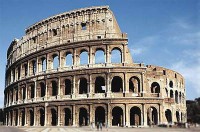 For most travelers to Italy, Rome is the furthest south they will travel. The golden triangle encompassing Rome, Venice and Florence is the main route. But the south has so much to offer! The regions of the south include, Lazio and within it Rome and Vatican city, Abruzzo, Molise and Puglia along the Adriatic, Naples and Campania, the toe of the boot Basilicata and Calabria, and the island of Sicily.
For most travelers to Italy, Rome is the furthest south they will travel. The golden triangle encompassing Rome, Venice and Florence is the main route. But the south has so much to offer! The regions of the south include, Lazio and within it Rome and Vatican city, Abruzzo, Molise and Puglia along the Adriatic, Naples and Campania, the toe of the boot Basilicata and Calabria, and the island of Sicily.
Lazio is a region of lakes, mountains, and vineyards. The area was formed by the eruption of four volcanoes and has left the region with numerous hot springs and volcanic crater lakes. Lazio’s best beaches can be found in the Parco Nazionale del Circeo between Gaeta and Sabaudia.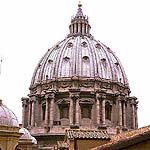
Naples, the capital of Campania, is an ancient city founded by the Greeks but conquered by the Normans, the French, Spanish and more. It has survived through grit and the feistiness of the people, which is evident today in this somewhat impoverished city. A few of the sights you might want to visit while there are Castel Capuano and Porta Capuana. The Castle was a royal palace until 1540 when it was transformed into the Court of Justice. The nearby Puerta Capuanais the finest Renaissance gateway in Italy. The Duomo was built between 1294 and 1323. The Museo Archeologico Nazionale is one of the world’s most important archeological museums in the world. Nearby is the petrified city of Pompeii buried in ash by the 79 AD eruption of Mt. Vesuvius.
The Amalfi coast is a real tourist draw because of the beautiful hill towns such as Sorrento, Praiano, Amalfi and Positano, the enchanting views of the Mediterranean and the Ile of Capri, just a ferry-boat ride away. Ravello offers the best views along this winding cliff-side drive.

Abruzzo, Molise and Puglia are the three regions forming a long strip along the Adriatic Sea. Dominated by the Apennine mountain range, this region has the contrasts of the Gran Sasso peak at 9554 ft. and The Adriatic sea’s glorious beaches. L’Aquila, Abruzzo’s capital lies at the foot of the Gran Sasso. Outdoor lovers are intrigued by the Parco Nazionale d’ Abruzzo, Lazio e Molise. This park is one of Europe’s most important nature preserves . This park is open for hiking, trekking and climbing.
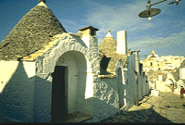 Bari, Puglia’s capital, a port city with ferries to Croatia and Greece is enhanced by the nearby Castle Del Monte, a UNESCO site. Alberobello is distinguished by the number of Trulli within its borders. Trulli are little, circular, white-washed buildings that have conical roofs. The origin of these buildings is obscure, but are interesting historically. Lecce is home to the Lecce Baroque style architecture mastered by Giuseppe and Antonio Zimbalo . Some examples can be found in the Chiesa de Rosario, the Palazzo Vescovile and Duomo, and the Santa Croce.
Bari, Puglia’s capital, a port city with ferries to Croatia and Greece is enhanced by the nearby Castle Del Monte, a UNESCO site. Alberobello is distinguished by the number of Trulli within its borders. Trulli are little, circular, white-washed buildings that have conical roofs. The origin of these buildings is obscure, but are interesting historically. Lecce is home to the Lecce Baroque style architecture mastered by Giuseppe and Antonio Zimbalo . Some examples can be found in the Chiesa de Rosario, the Palazzo Vescovile and Duomo, and the Santa Croce.
One of the poorest regions of Italy, Basilicata and Calabris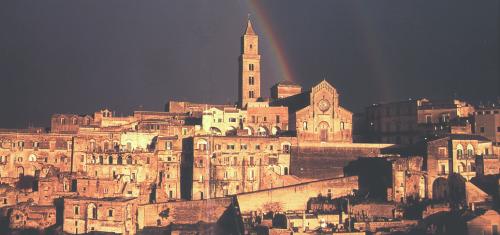 form the toe of the “Italian Boot”. Scattered with Greek ruins, and isolated towns, this region is almost virgin territory for tourists. Matera offers fantastic views from its perch atop a cliff. The Sassi section, below the bustling city, was once home to Materan cave dwellers. Tropea is one of a string of unspoiled, picturesque towns along the Mediterranean.
form the toe of the “Italian Boot”. Scattered with Greek ruins, and isolated towns, this region is almost virgin territory for tourists. Matera offers fantastic views from its perch atop a cliff. The Sassi section, below the bustling city, was once home to Materan cave dwellers. Tropea is one of a string of unspoiled, picturesque towns along the Mediterranean.
Sicily was a crossroads from Africa and Europe and has retained customs from the many cultures that crossed its path. Mt Etna has provided the fertile land that gives this island agricultural abundance. Tourism is still relatively low, so lovers of history and rich Italian cuisine should put Sicily travel on their short-list.
Palermo is an exotic city worth exploring. A few of the many main sights are the Duomo, Palazzo Reale, La Mangione, and Villa Guilia. The Duomo at Monreale with its glorious mosaica is one of the finest examples of Norman architecture in Sicily. The Port of Marsala evokes memories of the sweet wine that has been produced here since the 18th century.
Taormina is one of Sicily’s most visited resorts. The well-preserved Greek Theater offers magnificent views of Mt Etna. 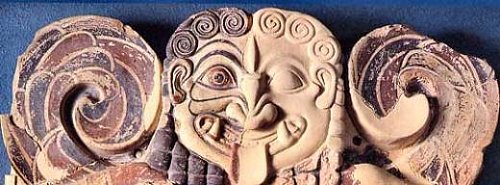 Siracusa, former Greek stronghold is filled with Greek temples and artifacts. The Museo de Archeologico Regionale Paolo Orsi has important artifacts from the Paleolithic to Byzantine eras.
Siracusa, former Greek stronghold is filled with Greek temples and artifacts. The Museo de Archeologico Regionale Paolo Orsi has important artifacts from the Paleolithic to Byzantine eras.


Comments